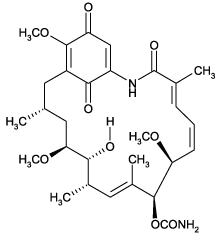Geldanamycin (CAS:30562-34-6)
产品名称: Geldanamycin (CAS:30562-34-6)
英文名称: Geldanamycin
产品编号: SIH-111B
产品价格: 0
产品产地: 加拿大
品牌商标: StressMarq
更新时间: null
使用范围: null
- 联系人 :
- 地址 : 加拿大
- 邮编 :
- 所在区域 : 其他
- 电话 : 138****6620; 点击查看
- 传真 : 点击查看
- 邮箱 : hedyl@stressmarq.com

Structure of Geldanamycin
Geldanamycin
is a benzoquinoid ansamycin produced by Streptomyces hygroscopicus. It
binds specifically to heat shock protein HSP90 and downregulates target
proteins including tyrosine kinases, steroid receptors, transcription
factors and cell cycle regulatory kinases (1,2). It induces the
inactivation, destabilization and eventual degradation of HIF-1α (3). It
is also an inhibitor of pp60src tyrosine kinase and of c-myc gene
expression in murine lymphoblastoma cells. It inhibits the transforming
activity of abl, erbB, fps, src, and yes (4). Geldanamycin is capable of
destabilizing several oncogene and proto-oncogene products; it is a
potent inhibitor of the nuclear hormone receptor family (5). It protects
against α-synuclein toxicity to dopaminergic neurons in Drosophila, and
destabilizes mutant p53 protein from a number of breast, leukemic, and
prostate cell lines (6). Inhibits basal and hypoxia-induced expression
of c-Jun (IC50=75nM) and abolishes hypoxia-induced increase in c-Jun
N-terminal kinase (JNK) activity. Inhibits telomerase activity through
inhibition of HSP90, a chaperone required for the assembly and
activation of telomerase in human cells (6). It is ~10-fold more potent
than herbimycin A.
1. Whitesell L., et al. (1994) Proc. Natl. Acad. Sci. USA 91:8324.
2. Neckers L. (2002) Trends Mol. Med. 8: S55.
3. Mabjeesh N.J., et al. (2002) Cancer Res. 62: 2478.
4. Chavany C., et al. 1996) Amer. Society Biochem Mol Bio. 9: 4974-4977.
5. Villa R., et al. (2003) Carcinogenesis. 24(5): 851-9.
6. Yamaki H., Iguchi-Ariga S.M., and Ariga H. (1989) J Antibiot (Tokyo) 42(4): 604-10.
发表文献
1. Cha, J.R.C. et al.
(2013). A novel small molecule HSP90 inhibitor, NXD30001,
differentially induces heat shock proteins in nervous tissue in culture
and in vivo. Cell Stress and Chaperones. doi: 10.1007/s12192-013-0467-2
